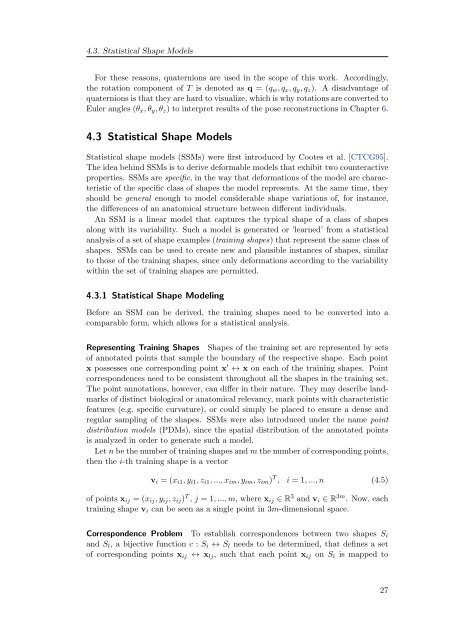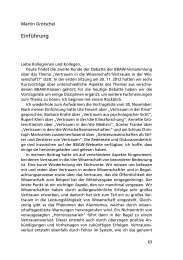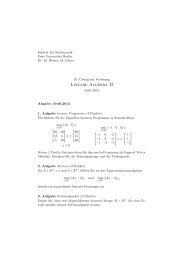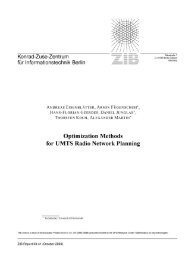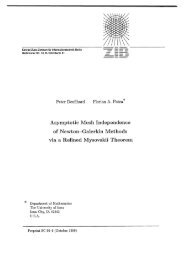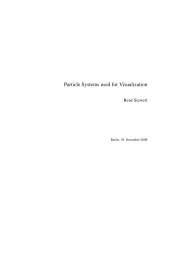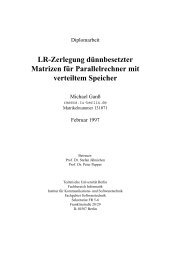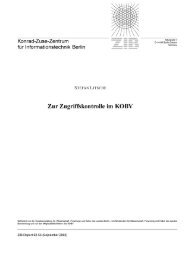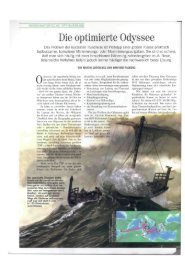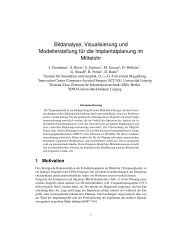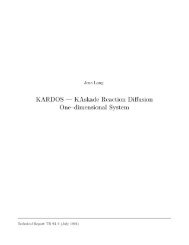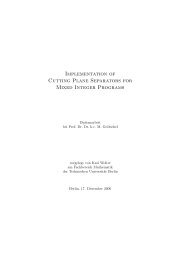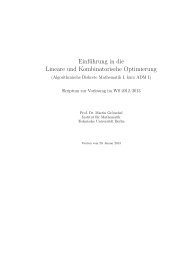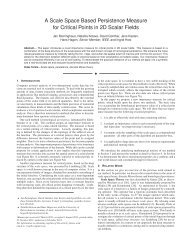3D Reconstruction of the Human Rib Cage from 2D Projection ... - ZIB
3D Reconstruction of the Human Rib Cage from 2D Projection ... - ZIB
3D Reconstruction of the Human Rib Cage from 2D Projection ... - ZIB
You also want an ePaper? Increase the reach of your titles
YUMPU automatically turns print PDFs into web optimized ePapers that Google loves.
4.3. Statistical Shape Models<br />
For <strong>the</strong>se reasons, quaternions are used in <strong>the</strong> scope <strong>of</strong> this work. Accordingly,<br />
<strong>the</strong> rotation component <strong>of</strong> T is denoted as q = (qw, qx, qy, qz). A disadvantage <strong>of</strong><br />
quaternions is that <strong>the</strong>y are hard to visualize, which is why rotations are converted to<br />
Euler angles (θx, θy, θz) to interpret results <strong>of</strong> <strong>the</strong> pose reconstructions in Chapter 6.<br />
4.3 Statistical Shape Models<br />
Statistical shape models (SSMs) were first introduced by Cootes et al. [CTCG95].<br />
The idea behind SSMs is to derive deformable models that exhibit two counteractive<br />
properties. SSMs are specific, in <strong>the</strong> way that deformations <strong>of</strong> <strong>the</strong> model are characteristic<br />
<strong>of</strong> <strong>the</strong> specific class <strong>of</strong> shapes <strong>the</strong> model represents. At <strong>the</strong> same time, <strong>the</strong>y<br />
should be general enough to model considerable shape variations <strong>of</strong>, for instance,<br />
<strong>the</strong> differences <strong>of</strong> an anatomical structure between different individuals.<br />
An SSM is a linear model that captures <strong>the</strong> typical shape <strong>of</strong> a class <strong>of</strong> shapes<br />
along with its variability. Such a model is generated or ’learned’ <strong>from</strong> a statistical<br />
analysis <strong>of</strong> a set <strong>of</strong> shape examples (training shapes) that represent <strong>the</strong> same class <strong>of</strong><br />
shapes. SSMs can be used to create new and plausible instances <strong>of</strong> shapes, similar<br />
to those <strong>of</strong> <strong>the</strong> training shapes, since only deformations according to <strong>the</strong> variability<br />
within <strong>the</strong> set <strong>of</strong> training shapes are permitted.<br />
4.3.1 Statistical Shape Modeling<br />
Before an SSM can be derived, <strong>the</strong> training shapes need to be converted into a<br />
comparable form, which allows for a statistical analysis.<br />
Representing Training Shapes Shapes <strong>of</strong> <strong>the</strong> training set are represented by sets<br />
<strong>of</strong> annotated points that sample <strong>the</strong> boundary <strong>of</strong> <strong>the</strong> respective shape. Each point<br />
x possesses one corresponding point x ′ ↔ x on each <strong>of</strong> <strong>the</strong> training shapes. Point<br />
correspondences need to be consistent throughout all <strong>the</strong> shapes in <strong>the</strong> training set.<br />
The point annotations, however, can differ in <strong>the</strong>ir nature. They may describe landmarks<br />
<strong>of</strong> distinct biological or anatomical relevancy, mark points with characteristic<br />
features (e.g. specific curvature), or could simply be placed to ensure a dense and<br />
regular sampling <strong>of</strong> <strong>the</strong> shapes. SSMs were also introduced under <strong>the</strong> name point<br />
distribution models (PDMs), since <strong>the</strong> spatial distribution <strong>of</strong> <strong>the</strong> annotated points<br />
is analyzed in order to generate such a model.<br />
Let n be <strong>the</strong> number <strong>of</strong> training shapes and m <strong>the</strong> number <strong>of</strong> corresponding points,<br />
<strong>the</strong>n <strong>the</strong> i-th training shape is a vector<br />
vi = (xi1, yi1, zi1, ..., xim, yim, zim) T , i = 1, ..., n (4.5)<br />
<strong>of</strong> points xij = (xij, yij, zij) T , j = 1, ..., m, where xij ∈ R 3 and vi ∈ R 3m . Now, each<br />
training shape vi can be seen as a single point in 3m-dimensional space.<br />
Correspondence Problem To establish correspondences between two shapes Si<br />
and Sl, a bijective function c : Si ↔ Sl needs to be determined, that defines a set<br />
<strong>of</strong> corresponding points xij ↔ xlj, such that each point xij on Si is mapped to<br />
27


